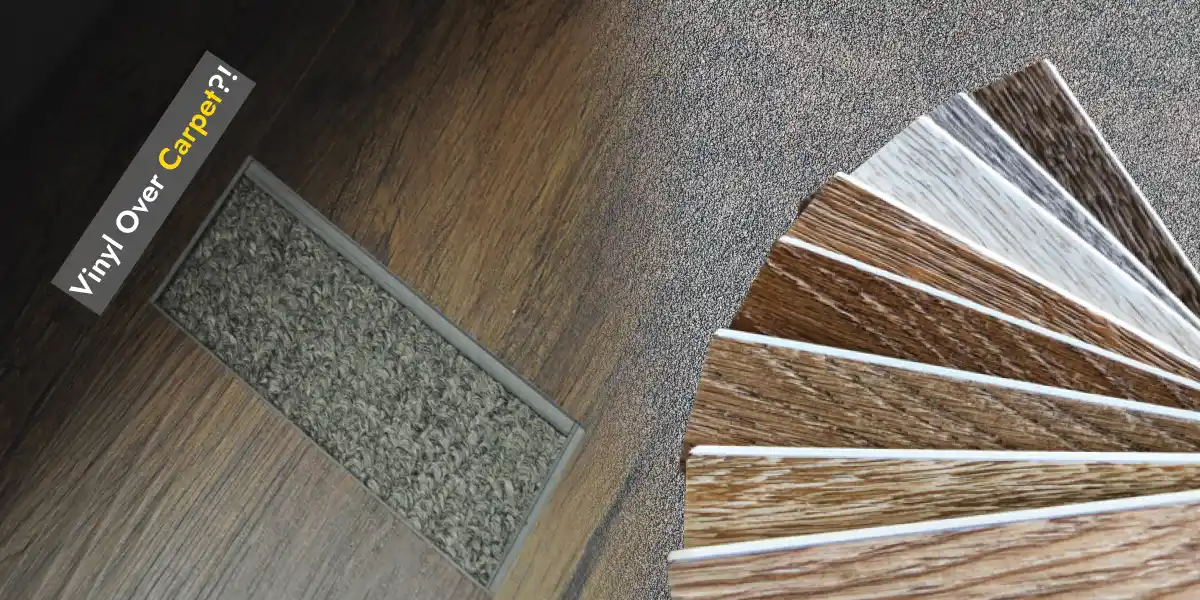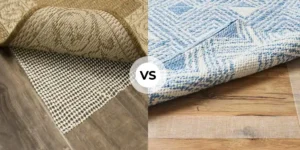Everyone wants to make their house more like a humble abode. Are you thinking of joining the workforce? Do you want to start on your floor? If yes, so it is a great decision.
Did you know that? Many homeowners have swapped their carpets for wood and vinyl. Because they are cost-effective, easy to install, attractive, and durable.
Well, now the question many people have is: Can you put vinyl flooring over the carpet?
The answer is yes. In some cases, it is possible to put vinyl flooring over carpet. But before installing the carpet, check its condition and make sure it is clean and debris-free.
So let’s start.
Can You Put Vinyl Flooring Over the Carpet?
While it’s possible to install vinyl flooring over carpet. It is generally not recommended. And may lead to issues with the long-term durability and stability of the flooring.
Vinyl flooring is designed to be installed on a flat, smooth, and rigid surface. Placing it directly over the carpet can create various problems:
- Uneven Surface: Carpet is a soft and flexible material, and installing vinyl directly over it may result in an uneven surface. This unevenness can cause the vinyl tiles or planks to wear unevenly and may lead to an unstable floor.
- Adhesion Issues: Vinyl flooring often requires a stable and adhesive surface for proper installation. Carpet fibers may interfere with the adhesion process. Causing the vinyl to lift or separate over time.
- Moisture Concerns: If there is moisture trapped between the carpet and the vinyl. It can lead to mold and mildew growth, damaging both the carpet and the vinyl flooring.
- Reduced Insulation: Placing vinyl directly over the carpet may reduce its insulating properties. Vinyl flooring is installed over a more rigid surface to provide better support and insulation.
If you are considering installing vinyl flooring and there is existing carpet. It’s generally advisable to remove the carpet first.
Installing Vinyl Flooring Over Carpet: Steps to Follow
Step 1: Supplies Needed:
- Utility knife
- Measuring tape
- Straight edge
- Adhesive or Underlayment
- Tapping block
- Moisture barrier (if necessary)
- Pencil or Chalk
- Spacer
- Broom and Dustpan
- Safety equipments
Step 2: Remove all the Furniture
Before installing vinyl flooring over the carpet, you should remove all furniture. It is best to move furniture and appliances if they are in the way and can cause injury.
Step 3: Assess the Existing Carpet
The next step is to assess the carpet’s condition. Make sure it’s clean, free from moisture, and lacks significant wear or damage.
Additionally, check the subfloor is not uneven or damaged by water.
If the carpet or subfloor has problems, the installation may not be successful. Ensure a proper and long-lasting vinyl flooring installation by addressing these concerns.
Step 4: Prepare the Floor
Vinyl flooring must be prepared before it can be installed over carpet. Make sure the existing carpet is thoroughly cleaned and sanitized.
Additionally, if moisture is a concern, consider installing a moisture barrier.
Moreover, when applying adhesive or underlayment, follow the manufacturer’s instructions. To ensure a successful installation, vinyl flooring requires a stable, clean foundation.
Step 5: Choose the Right Vinyl
Good vinyl flooring should be chosen when installing vinyl over carpet. As a first step, consider your home and carpet, then choose a suitable vinyl flooring that fits your home.
But here is the twist: don’t forget to measure the room’s dimensions and the flooring you’ll need. To prevent squeaking, buy the right amount of flooring and install enough padding.
Moreover, ensure the vinyl flooring you choose is durable and has a good warranty. Also, make sure that it is easy to clean and maintain.
Step 6: Apply Vinyl Adhesive
When vinyl flooring is installed over carpet, adhesive is required to improve the bond.
Additionally, adhesives prevent water from seeping into the carpet, where it can cause damage to it.
Moreover, the carpet may shift without adhesive, and the vinyl flooring may become loose. As a result, the flooring is more durable and less likely to collect dust.
Step 7: Apply Vinyl Flooring
Once your floors and carpet are cleaned, you can install vinyl flooring over the carpet. First, you need to lay an underlayment over the carpet.
Next, you can lay the vinyl on top of the underlayment, making sure to smooth out any air bubbles. Then, you can use a sealant around the edges of the vinyl to make sure it is properly sealed.
Step 8: Trim Excess Material
Trimming excess vinyl flooring material after installing it over the carpet is important. Use a utility knife to do this work.
When cutting the material, it is important to stay careful to avoid damage.
Additionally, cut in a back-and-forth motion from the corner of the room. Once the desired shape has been achieved, smooth the edges with a sander. Then, vacuum the area to remove any debris.
Step 9: Care and Maintenance
After installing vinyl flooring over the carpet, it requires proper care and maintenance.
Cleaning your floors regularly with a vacuum and sweep will keep them dirt-free. Plus, clean spills quickly with a damp cloth to prevent excess moisture.
Moreover, avoid sharp tools and harsh chemicals that may damage the surface. It is best to clean and maintain a dry environment for vinyl flooring.
Pros and Cons Of Vinyl Flooring Over Carpet
Pros
- It is more affordable than removing the carpet and preparing the subfloor.
- It is a quick installation process.
- The surface is easy to clean and maintain.
- It is also lightweight, making it easy to install and transport.
- It’s a great choice for a temporary solution
Cons
- Changing the floor height can cause issues with transitions and doors.
- Moisture trapped inside can cause mold and damage.
- The warranty on vinyl flooring may be voided.
Why Do You Prefer Vinyl Flooring Over Carpet?
Many homeowners prefer vinyl flooring to carpet because of its various advantages. Vinyl is extremely durable and capable of resisting heavy foot traffic, spills, and wear and tear. As a result of its longevity, it is a cost-effective option in the long run.
It’s also easier to maintain than carpeting, which requires occasional sweeping and vacuuming. Also, it is easy to install and maintain, so it makes a good choice for low-maintenance flooring.
How to Choose the Best Vinyl Floor for Carpet?
The best vinyl flooring for carpet will depend on the type of vinyl (sheets, tiles, or planks) you prefer. It is easiest to install sheet vinyl flooring, while tile and plank vinyl flooring offer more design options.
Additionally, sheet vinyl flooring is easier to maintain than tiles and planks. Ultimately, the vinyl flooring that is right for you will depend on your preferences and needs.
Check Out More Articles About Floorings:
- How to Clean Old Hardwood Floors After Removing Carpet? (5 Easy Steps)
- 9 Best Ways to Remove Gorilla Glue from Carpet (Includes Natural Ways!)
- 4 Best Ways to Cover Gap Between Floor and Wall (Must-Try!)
- The Best Way to Level a Concrete Floor For Laminate Flooring (Must Read!)





